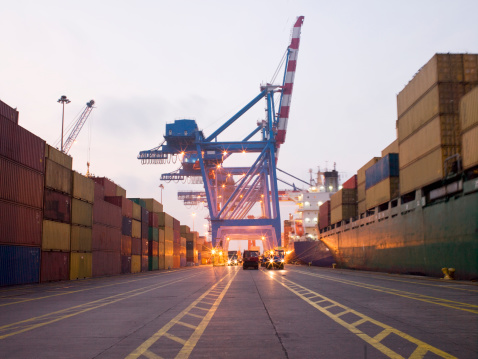
There was a special focus on how port-related issues are driving real estate development at last week’s Bisnow National Industrial and Logistics Summit Northeast held in New York. Bisnow’s Miriam Hall did a great report on the experts’ view of commercial real estate market trends. Beyond the supply and demand of the current market, there were a few longer-term trends and issues that recurred throughout the day.
It’s all about the trucks
Trucking is the key mode of transport for moving goods in and out of ports, and it is increasingly the link in the supply chain driving the nature of industrial real estate development. Depending on who you ask, there’s either a shortage or truckers or a terribly inefficient allocation of existing resources. Either way, it’s creating a growing burden on logistics: the average age of truck drivers is now is 57, costs are up as much as 35%, and the American Trucking Association ATA estimates there is a shortage of nearly 69,000 truckers.
ELDs
Another hot topic of discussion throughout the day was the state of the trucking industry and the effect of mandated Electronic Logging Devices (ELDs). ELDs bring the traditional DOT-required driver logs into the 21st century by automatically tracking hours of service. While the system could lead to greater safety, there are significant costs for initial investment, especially for smaller owner/operators. The new system also means that a few minutes delay here and there cannot be fudged as many acknowledge has been done in the past, making efficiency even more important.
Gateway Ports
Going forward, experts see the maritime industry coalescing around a limited number of “gateway” ports capable of providing the infrastructure and service needed to compete for container traffic. With an expanded Panama Canal and larger ships, channel depth and air draft are two of the most obvious attributes that will define gateway ports.
Equally important is what you do with cargo once it’s offloaded. Larger ships and fewer steamship lines create the risk that gateway ports will become choke points unless they can achieve the velocity needed to move goods quickly through the port. Many ports have established truck appointment systems, and ELD requirements are only putting greater pressure on scheduling. Facilities need to be configured to handle this volume, and having a sufficient number of Customs agents on hand when cargo is moving through is vital.
Site Selection
Low supply and high demand means that warehousing properties situated near ports are commanding a premium right now. Long-term, experts expect distribution points to move closer to markets as land become more scare at ports.
That need in part prompted the Port of Virginia to create inland intermodal facilities to which containers are transported by rail and barge for distribution. Not only does this solve the landside storage problem, it avoids the need for added truck traffic at the port. The future will likely bring strategic alliances between private developers and public ports (especially landlord ports) to solve these warehousing and transportation issues.
Site Design
The changing nature of logistics activity is driving changes in the physical configurations and attributes of warehousing as well:
- E-commerce fulfillment centers require more parking (and more land) than traditional distribution facilities.
- The configuration of dropyards will need to be more efficient to minimize ingating and outgating times.
- Next-day delivery will drive more multistory warehouse/industrial uses in urban areas. These are expensive build, and older building stock may not have required clearances and engineering.
- Expect to see vacant big box start to fill last-mile needs.
Technology
As with many industries, technology is affecting logistics in the present and not-too-distant-future:
- Electric trucks: Can save 25 cents/mile, helping to offset ELD compliance costs and dampen effect of low supply.
- Load-Matching Apps: Sometimes called Uber for trucks, linking truckers with loads to improve utilization of trucking resources. Two of the most prominent are Convoy and Transfix.
- Blockchain: Encrypted transactions of products more attractive.
- Drone delivery: FAA clearance could one day be a factor in site selection.

Anthony V. Mannino
Chief Operating Officer, Wolf Commercial Real Estate (WCRE)
Sr. Consultant, Triad Strategies
Board Member, PhilaPort
Greater Philadelphia Area Commercial Real Estate


